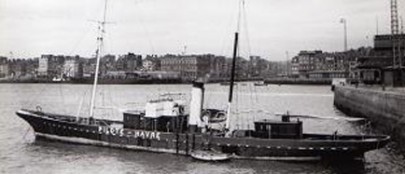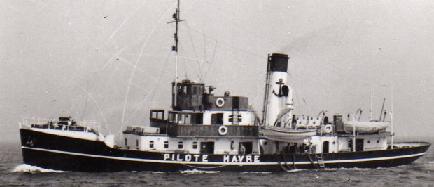Long range piloting between 1517 and 1914
On the 7th of February 1517 the King, François the 1st, signed a warrant that ordered the creation of the port of Havre de Grâce. The site was nothing more than a cove at that time, and was often used as a refuge for local boats. The same year on the 16th of April, the first dig began; a channel was formed in the Perrey and the cove was transformed into a basin.
It was the beginnings of the rapid development of this port of war that incited his son, King Henri II, to issue the first known text relative to pilotage in Le Havre; this legislation, dating from the 15th of July 1551, states that “ the foreman of the vessel, in order to avoid any danger of threatening the livelihood of men or of the hold, will be required to take a pilot in all places where the necessity and use of one commands; if he does not do this, he will be punished each time with a 50 gold pieces fine…”.

Due to the decree of 1584, the admiralty set up the pilotage service. It created the “deep sea pilotage” and announced the composition of the jury delegated to deal with the examination of applicants.
In January 1629, the decision was made to create schools of hydrography for pilots. Every port, including Le Havre, would have one.
In 1681, Colbert ordered a reorganisation of pilots through a major ordonnance. Long range piloting, competition amongst pilots, individual cutters, prohibition of a common fund…became regulation in Le Havre.
In 1678, a group of deep sea pilots was established and hired by the state in order to specifically serve the king’s vessels. The following year he instated harbour pilots.
During the XVII and the XVIII centuries, two categories of pilots existed in Le Havre. On the one hand, harbour pilots who specialised in piloting the river or the roads, and were hired for their local knowledge, helped with the coming and going of vessels. On the other hand, deep sea pilots who navigated at sea and put themselves forward to incoming vessels in order to offer their services. Trained by a professor of hydrography, these pilots brought their knowledge of navigation and manoeuvring to the captains. They boarded either commercial ships or vessels belonging to the king.
Nonetheless, due to the decree of the 22nd of April 1791 by the legislative assembly, deep sea pilotage was abolished, leaving only the harbour pilots. The text then demanded that they be better qualified and more experienced in order to practice pilotage. The text also imposes compulsory pilotage for all vessels.
Under the rule of Napoleon the 1st, the Act of the 12th of December 1806 made another important change. It defined the organisation of the profession and how pilots were nominated and included details regarding the taxes and salaries, the rules of service, sanctions, the role of the head of pilotage, the management of equipment, the way elderly pilots were dealt with… All of these elements were to be partly reused in the 28th of March 1928 Act, which is still in force today. In 1850 there were a total of 48 pilots in Le Havre, 12 trainee pilots and a 100 linesmen, to be able to crew the pilot boats and barges. The sea service was carried out using 20 all weather boats. A head pilot controlled the service details. The limit of the pilotage zone of Le Havre extended westbound from the Casquets longitude and eastbound to the Dungeness longitude (limits of 1855). Each pilot was then the owner of his pilot boat which had a crew of 3: a skipper, a seaman and a deck hand. It was the era of cutters better known by the name of “hirondelles de la mer” due to their colour (black hulls and white bulwark).
In 1908, at a time when long range pilotage appeared to be out of date, mainly due to the development of the propeller, a project of national reform initiated by pilots and the Chamber of Commerce was rejected. This reform was aiming to pool salaries and use of equipment and abolish long range pilotage.
From 1914 until today, a local pilotage, a collectivity

In 1914 the First World War broke out. Pilots, “unavailable registered sailors”, no longer had the benefit of the freedom to exercise their profession and found themselves forced to abandon the deep sea and made to work in the immediate port area. The 36 cutters belonging to the port were laid off as they were unsuitable for work on the roads. The “each man for himself” attitude was given up, and from then onwards pilots carried out their profession close to the shore using a rota system for the incoming and outgoing vessels. Two steamers and a few cutters were requisitioned by the admiralty for the use of the pilot services. The community of pilots at the station purchased their first steamer in 1916; the Illiona. This new organisation remained after the war.
Following the general assembly of the 17th of November 1921, the white flag with a black anchor was replaced by a green flag with a white anchor.
On the 1st of June 1923, the Illiona was replaced by the steamer Hermann du Pasquier. In 1924, the Quatre Frères Biard steamer joined the fleet to complete the equipment.
The 28th of March 1928 saw the enactment of the new maritime pilotage Act. Concluding a legal process of different reforms put into place progressively in the ports since the beginning of the 1st World War, the new Act particularly dealt with compulsory pilotage and the recruitment of pilots. It made the law regarding salaries and materiel etc., more compatible. For Le Havre, the first fruits of this new law were reaped by the purchasing of a new vessel, the Louis Brindeau, in January 1933. The Louis Brindeau replaced the old Hermann du Pasquier. The Le Havre de Grace replaced the Quatre Frères Biard in May 1936. In June 1937 the pilots gave up the management of linesmen. On the eve of the Second World War, the station looked to the future with confidence: traffic was good, the operational 48 pilots corresponded to the needs, and the more modern boats adapted well to the demands of the service. This favourable situation was turned upside down by the war and the collapse of June 1940. The economy of the station was threatened, staffing was reduced to 50% by the end of the war (deaths, illnesses, retirements, mobilisation), almost all of the equipment had disappeared (the Havre de Grace and the Louis Brindeau left France after being requisitioned and were found in a very damaged state at the end of the war), pilots and retired pilots were left unpaid until 1941 due to a lack of funds. Under the rule of Vichys’ government the station however had avoided collaborating with the Germans. In 1950, the station was awarded the “Croix de Guerre 1939-1945” (the War Cross).
The liberation of 1944 was the opportunity for a new start. Despite difficult working conditions, the pilots put themselves at the disposal of the allies and contributed to the rebirth of the port.
The Le Havre de Grace I was put back into service in 1947. It was quickly followed by Louis Brindeau. The Havre de Grace I was nonetheless replaced in 1958 by a new vessel, the Françoyse de Grace. The latter stayed at the station until 1968 until it was replaced by the Havre de Grace III. The Louis Brindeau was also taken out of service the same year.
In 1969, the decree of the 19th of May put an end to the old practice of pilot of choice. This subject had been a bone of contention because it was contrary to the collective spirit and to the common interest of pilots.
Following the start of the new oil terminal in Antifer, the station acquired its first helicopter, in March 1976, for the boarding/disembarking of pilots.
The stations of Le Havre and Fécamp merged in 1976. In 1985, the pilot boat Havre de Grace III was taken out of service; thus the pilots only used launches and the helicopter. In 1986, the station moved to the ‘Quai de la Marine’. The ship handling simulator started to be used in March 2004.
In September 2005, the station was under shock due to a tragic helicopter accident. A fellow maritime pilot and the helicopter pilot were killed.
Handling vessels ever more imposing, the pilots of Le Havre served the biggest container ship currently in service, the EUGEN MAERSK, on the 19th of February 2008. Her dimensions are impressive : 397.70 metres long, 56.40 metres wide, a speed of 26 knots and a draft of 16.00 metres when fully loaded.

Bibliography
- Archives station de Pilotage Le Havre Fécamp
- Ouvrage “Les pilotes maritimes Français – Cent ans de métier” de Marie Françoise Pochulu – Edition des falaises.
- Ouvrage “Les pilotes du Havre – 1806 / 1914″ de Claudie Reinhart
- Ouvrage “Les pilotes du Havre – 1914 / 1945″ de Julien Richard.
- Ouvrage “Pilotes – Les hirondelles de la Manche – Pilotes du Havre” de Pierre Henri Marin



